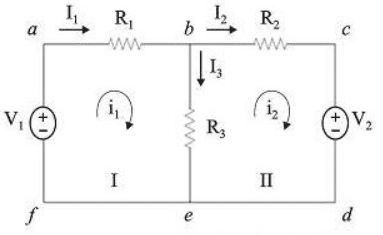In this second part, will be presented two circuit analysis methods. Will be shown only DC circuits with resistors.
To see the first part, click in the button below.
Circuit analysis (Part 1)Click here
Nodal analysis or node method
What is a node in a circuit? Are points or junctions where are linked components in a circuit. For example, this circuit has 4 nodes.

The procedure to application of this method:
- See how many nodes the circuit has.
- Choose a node to be the reference node, it must be grounded.
- Give names to other nodes, like for example: V_{1}, V_{2} ou V_{A}.
- Apply Kirchhoff’s law to currents (shown in part 1) to node currents, except to the reference node.
- Solve the equations, to find out the node values. Number of equations is equal than number of nodes minus 1.
This is an example of circuit to apply the nodal analysis, has 4 nodes.

Step 2: The reference node was chosen and grounded. A hint is always choose the one connected to negative pole of a voltage source as reference node.

Step 3: Give names to other nodes.

Steps 4 and 5: Obtain and solve the equations. Fortunately, we know the V1’s value, therefore, we need only two equations. This is the V2 node equation.
7=\frac{V_{2}}{30}+\frac{V_{2}-V_{3}}{26}+\frac{V_{2}-V_{1}}{20}
And this is the V3 node equation.
6=7+\frac{V_{3}}{50}+\frac{V_{3}-V_{2}}{26}
Making algebric manipulation, we have:
V_{2}=70,91V e V_{3}=29,55V


Mesh analysis or method
What is a mesh in a circuit? Are closed “loops” in a circuit, for example, this circuit has 3 meshs and the previous circuit has 4 meshs.

This method uses Kirchhoff’s law for voltages to find the mesh currents in a circuit. The procedure to apply this method consists in:
- Assume an indenpendent current circulating in each mesh clockwise.
- Give a name to each mesh current, like I_{1}, I_{2} or I_{a}.
- Use the Kirchhoff’s law for voltages to obtain the equations. The number of equation is equal than number of meshs.
- Solve the equations to find mesh current values.
This circuit is an example to apply mesh analysis.

Step 1: See the indenpent currents in each mesh. Step 2: Give names to these currents.

Step 3: Writing the equations of I_{1}, I_{2} and I_{3} meshs respectively.
50=5000\cdot I_{1}+500(I_{1}-I_{2})+2000\cdot I_{1}
500(I_{1}-I_{2})=10+50(I_{2}-I_{3})+100\cdot I_{2}
50(I_{2}-I_{3})=1000\cdot I_{3}+6
Step 4: Making algebric manipulation, there are the current values.
I_{3}=-6,25mA I_{2}=-0,011A I_{1}=-0,011A


In circuit analysis, exist cases where it is necessary to apply the supermesh method. It is used in situations where there a source of indenpedent current without resistance in parallel.

To obtain the supermesh equation, must replace the current independent source for a open circuit.




